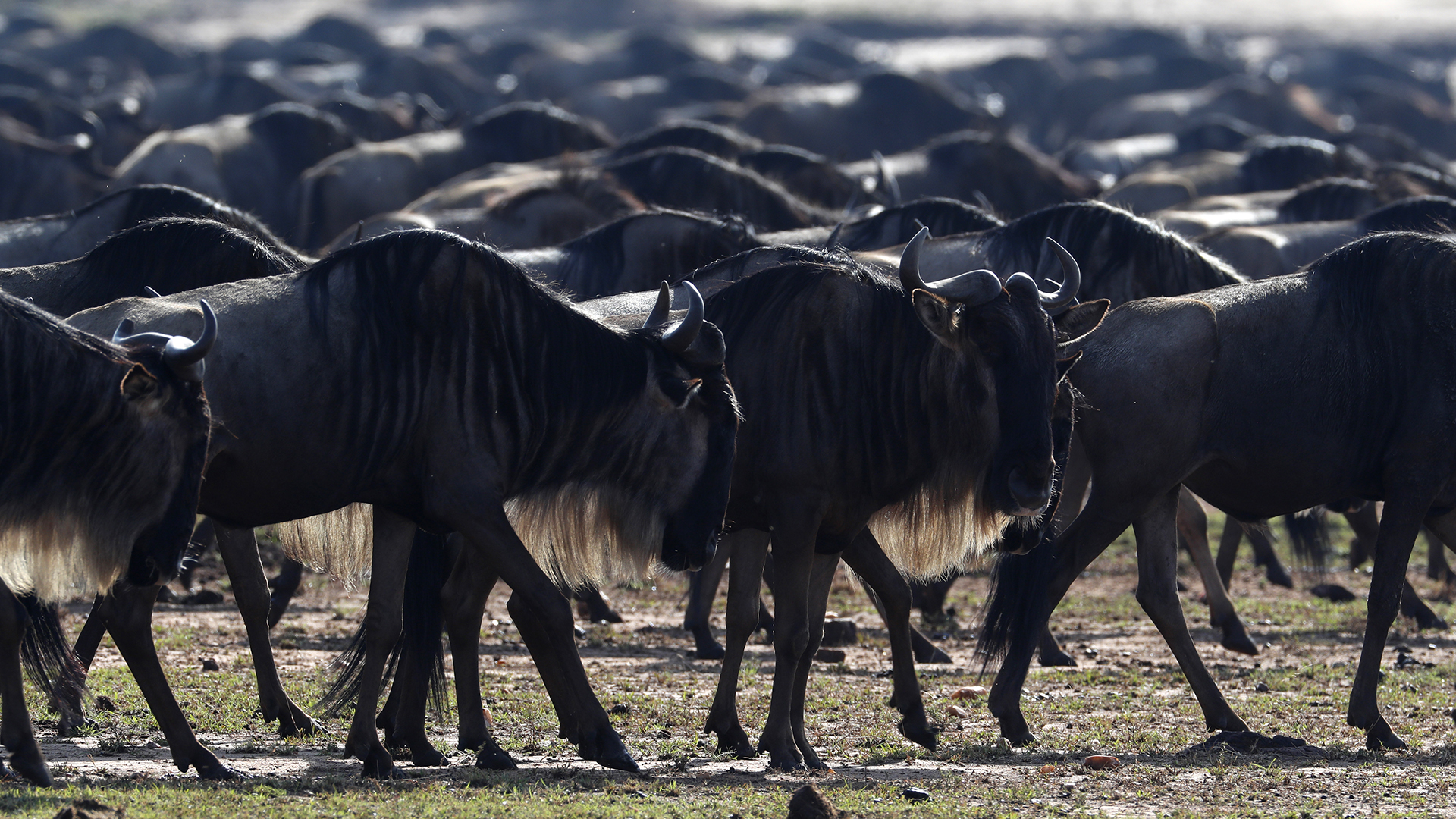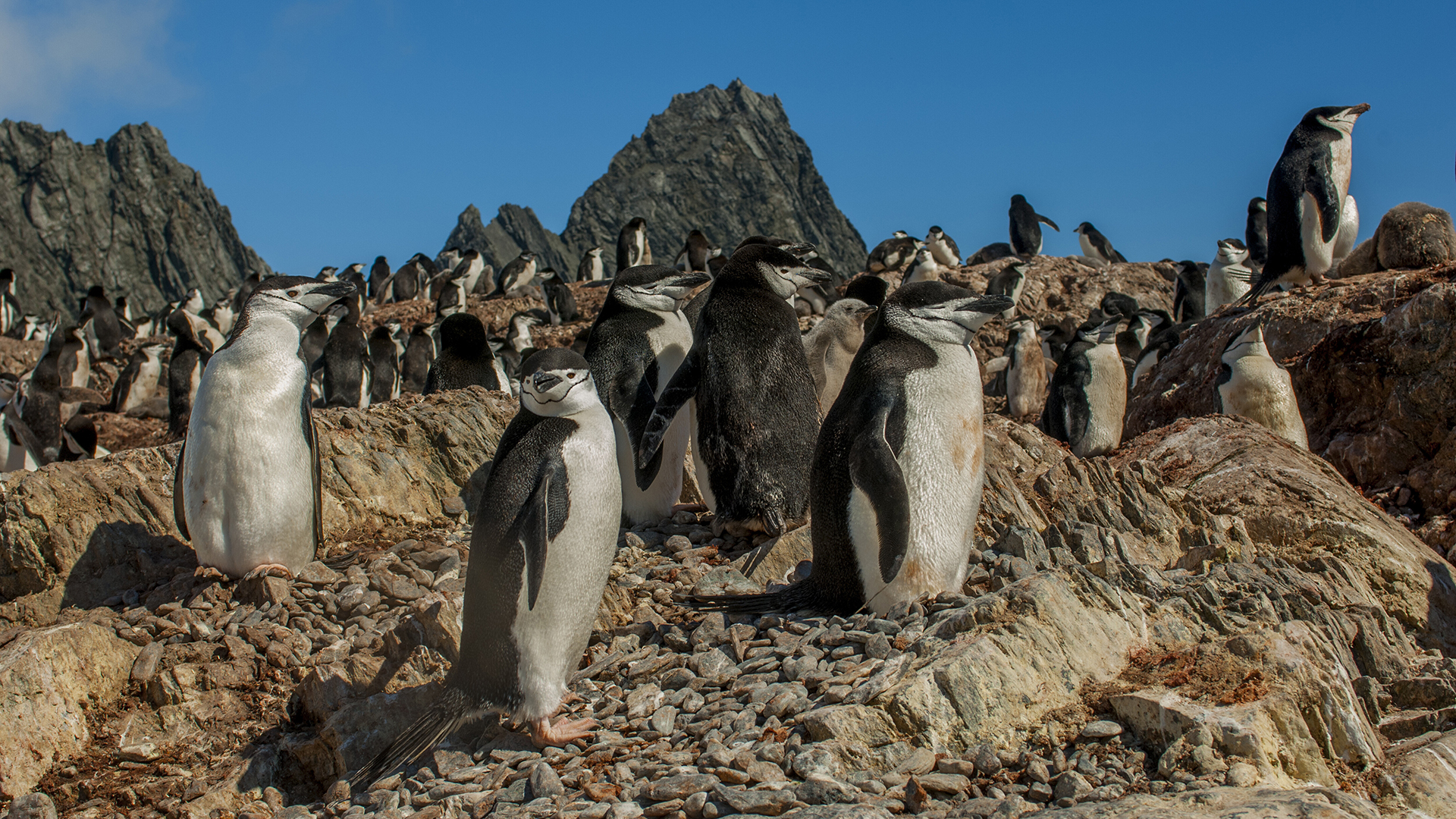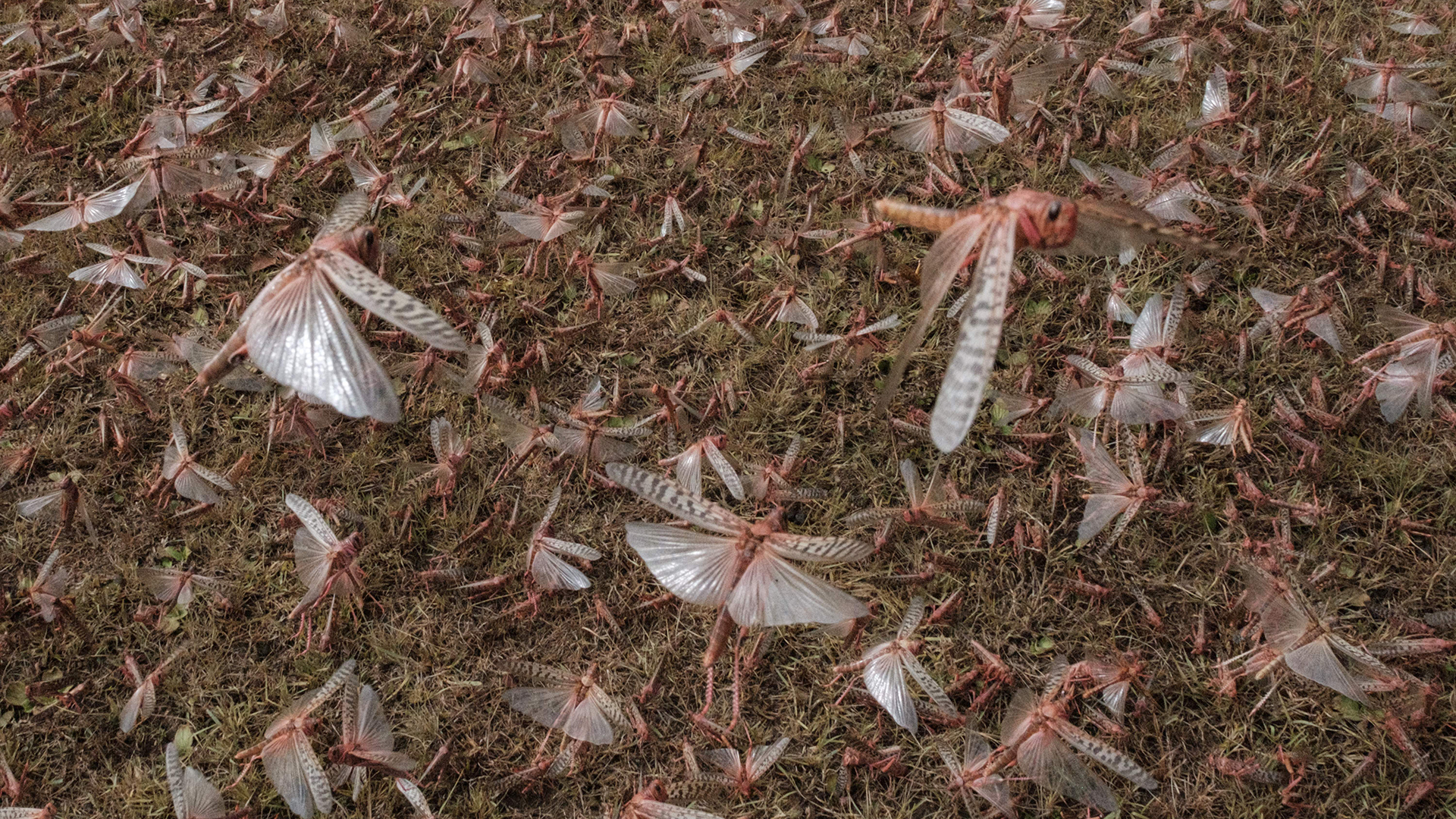What's the biggest group of animals ever recorded on Earth?
For these gregarious animals, 'alone time' is a fantasy.

In early 2020, ornithologist Noah Strycker found himself walking amongst several thousand chinstrap penguins on Elephant Island, a remote blip of snow-covered rock just off the Antarctic Peninsula. He was there to carry out a census of the island's penguin colony, which hadn't been properly surveyed since 1970. "I'll never forget the sight, sound, and...smell," joked Strycker, a graduate student at Stony Brook University in New York, as well as a professional bird watcher, and author.
The survey that he and his colleagues eventually produced revealed that chinstrap penguin numbers are in decline. But despite this, this species actually forms one of the biggest colonies of penguins on Earth — gathering in the millions in some Antarctic locations. But counting these animals doesn't daunt Strycker, who has actually developed something of a hobby for this task.
It started a few years ago when he found himself pondering how many starlings were contained in the magical murmurations that these birds form, and which swell and undulate across the evening sky in many parts of the world. "They are quite beautiful. It almost looks like smoke," Strycker told Live Science. "And it just gets you wondering, how many of them are there?" The answer, he discovered, was that there are roughly 1 million in the average murmuration, all soaring and swooping in unison. That discovery spurred Strycker on to answer an even more ambitious question: beyond birds, what's the biggest group of animals ever recorded on Earth?
Related: What's the first species humans drove to extinction?
Answering this question takes us to some very interesting places — back into the past, up into the sky, down into the ocean and sweeping across desert plains. It offers magnificent proof of the abundance of animal life on Earth, but it also points to humanity's role in reducing — and, unexpectedly, increasing it too.
Thousands, millions, billions
When Strycker embarked upon his unusual quest, he shared his discoveries in his book called "The Thing with Feathers: The Surprising Lives of Birds and What They Reveal About Being Human" (Penguin Random House, 2014). As the title suggests, birds are high contenders for the title of most numerous group. At 1 million per flock, starling numbers are jaw-droppingly high — but they're easily outnumbered by chinstrap penguins, which can reach 2 million on the South Sandwich Islands off Antarctica.
But those charismatic penguins fall far behind the red-billed quelea: this small species that can gather in single flocks of several million over savannah and grassland areas in sub-Saharan Africa — so huge that they seem to roar as they pass overhead. "I think they're considered now to be the most abundant species of bird in the world. And they do make very large flocks in the millions — tens of millions, maybe hundreds of millions," Strycker said. Their explosive success as a species may be helped by agriculture's spread: these birds consume grass seeds, but they'll also settle for fields of cultivated grain. As such, they're loathed by embattled farmers who lose huge shares of barley, buckwheat and sorghum harvests to these birds every year.
Get the world’s most fascinating discoveries delivered straight to your inbox.
Quelea are so numerous that observers say it can take five hours for a flock to pass overhead. But here is where this species yields to an even more populous bird that once was abundant across American skies: the passenger pigeon. "There are stories of people standing there and watching a single flock of passenger pigeons fly over them for hours or days at a time, which is crazy!" Strycker said. One gathering in 1866 was recorded as 1 mile (1.6 kilometers) wide and 300 miles (482 km) long, and was estimated to contain about 3.5 billion birds, based on the number of pigeons per square mile and extrapolated across the size of the flock. Of course, that was before hunting drove this successful species to extinction.
So surely with that grand tally, this pigeon of yore takes the prize for most populous creature on Earth? Not so fast: there are quite a few other contenders to consider still.
Related: Why are there so many pigeons?
Shifting our gaze down from the skies, and into the ocean's depths, there are records of fish species — specifically Atlantic herring — gathering in schools that exceed 4 billion — the passenger pigeon's closest contender for the reigning title so far. Other species don't come close to the numbers tallied up so far — but they're still so impressive to behold that they deserve a mention. These include migratory mammals like springbok and wildebeest in southern Africa that have, in the past, gathered in herds exceeding 1 million, forming vast processionals that march across the sun-beaten savanna for weeks. These are further outstripped by their winged mammalian cousins: in Texas, there's a single cave that's home to more than 20 million Mexican free-tailed bats, whose closely-packed bodies transform the cave's interior into a rippling, writhing mass.
Yet there's one animal whose enormous gatherings leave all these other contenders behind in a trail of dust. (Or rather, a trail of decimated vegetation and ravaged crops.)
A gathering swarm
In East Africa earlier this year, a veil of insects swept across the sky, forming a mass of spiky legs and fluttering wings that spanned nearly 930 square miles (2,400 square km). "It was literally like a black blanket that went over the clouds. It was difficult to even see the clouds," said Emily Kimathi, a researcher at the International Center of Insect Physiology and Ecology in Kenya.
That swarm was composed of desert locusts, a species that turns up in huge numbers sporadically in East and North Africa, as well as parts of the Middle East and South Asia. That particular event was the largest swarm seen in the Horn of Africa in 25 years. Experts estimate that locusts swarm at a density of about 50 million per 0.3 square miles (1 square km), so that means the single 2020 throng would have contained roughly 200 billion locusts, said Kimathi, who studies the desert locust. "[The species] can increase up to 20 times its population in a span of three months."
What Kimathi is concerned about is how much more frequent — and larger — these swarms could become. The desert locust needs two things to thrive: heat, and moisture, which is crucial for the eggs to hatch from the desert sands. And fortuitously for locusts, climate change is increasing these conditions across their vast range. "These areas are getting more arid, and when they do receive the rainfall, it's torrential rain," Kimathi said. "These conditions are becoming more frequent. And so these areas are becoming more favorable for locusts to breed."
Related: What makes grasshoppers swarm?
In this case, the gathering of gregarious animals isn't just a spectacle to behold; a voracious swarm of locusts can decimate farmers' crops in a matter of hours, ruining livelihoods and increasing food insecurity for millions.
Kimathi is trying to tackle this enormous challenge in her research. In a recent study published in July in the journal Scientific Reports, she used meteorological data, paired with information on the breeding patterns of desert locusts, to develop models that identify precise geographical locations across the region where species are most likely to breed in the future. She's hoping her findings will inform early-warning systems that countries can use to predict where locusts will breed, so they can be intercepted before eggs hatch and take to the skies in ever-growing swarms.
Two-hundred billion is an eye-popping number. But a clue from history suggests that locust swarms can grow much more numerous, given the perfect conditions. In 1875, an amateur meteorologist named Albert Child stood, bewitched, as locusts whizzed across the sky in a swarm that ultimately cloaked a large portion of the western United States. The species was the Rocky Mountain locust, and Child estimated the swarm covered an area of 198,000 square miles (512,800 square km).
This historical event became known as 'Albert's Swarm', and based on Child’s estimates, it was thought to contain not millions, not billions, but trillions of insects. Three-and-a-half trillion, to be exact. And that, in fact, is thought to be the largest number of animals in a group ever recorded by a human. Rocky Mountain locusts have since gone extinct — but their historic flight offers us a cautionary look at those other swarms, gathering across the planet today.
Will we ever know?
It's overwhelming to contemplate what several trillion locusts looks like. But, take a breath, because there's one final contender on our list — if we go with a slightly more liberal definition of what a 'group' entails. That's because beneath the Earth's surface, we find creatures that gather in colonies so vast, it's almost inconceivable that they form a unit.
This is the Argentine ant, which was unintentionally introduced from South America to Europe about 100 years ago. This industrious creature has formed the world's largest known continuous colony: a behemoth that stretches 3,700 miles (6,000 km) underground across vast swathes of Europe. The stretch is made up of several hundred nests that each contain billions of ants — so it's likely that the whole system collectively contains trillions. But getting to a closer estimate has proven elusive: the task of counting these insects may simply be too challenging.
This underscores the difficulty of answering this deceptively simple question, of what animal forms the biggest group. "It seems like such a quantifiable question, and yet the more you dig down into it, the harder it becomes to define what do you mean by a 'group'. It's so difficult to estimate large concentrations," Strycker said. And what's more, as the case of the locusts reveals, "The more you dive into it, the more you can't answer that question without talking about ourselves," he said. The boom and bust of animal populations isn’t something we can separate from human influence.
Maybe the important thing is that contemplating the sheer abundance of life on Earth — and the roles humans play in making it fall, and rise — will help us do a better job of protecting it.
Editor's Note: This piece was updated Dec. 23 to clarify that chinstrap penguins form one of the largest penguin colonies on Earth, but not, in fact, the largest.
Originally published on Live Science Dec. 19, 2020, and republished on July 28, 2022.

Emma Bryce is a London-based freelance journalist who writes primarily about the environment, conservation and climate change. She has written for The Guardian, Wired Magazine, TED Ed, Anthropocene, China Dialogue, and Yale e360 among others, and has masters degree in science, health, and environmental reporting from New York University. Emma has been awarded reporting grants from the European Journalism Centre, and in 2016 received an International Reporting Project fellowship to attend the COP22 climate conference in Morocco.





